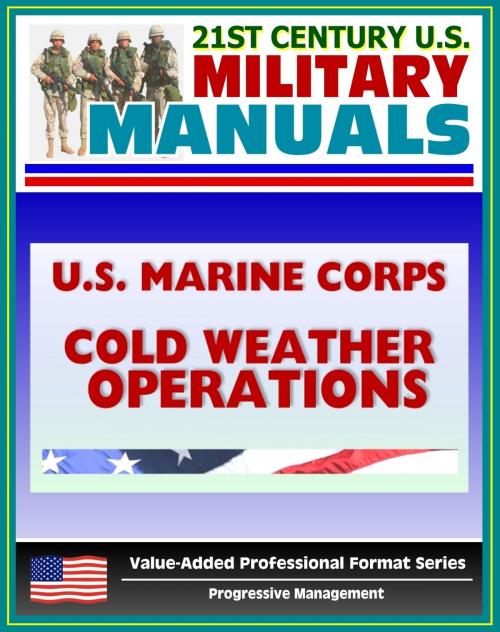21st Century U.S. Military Manuals: U.S. Marine Corps (USMC) Guide To Cold Weather Operations MCRP 3-35.1A (Value-Added Professional Format Series)
Nonfiction, History, Military, Naval, United States| Author: | Progressive Management | ISBN: | 9781465877130 |
| Publisher: | Progressive Management | Publication: | February 16, 2012 |
| Imprint: | Smashwords Edition | Language: | English |
| Author: | Progressive Management |
| ISBN: | 9781465877130 |
| Publisher: | Progressive Management |
| Publication: | February 16, 2012 |
| Imprint: | Smashwords Edition |
| Language: | English |
Part of our value-added professional format series of U.S. military manuals, this U.S. Marine Corps manual addresses individual and collective skills necessary for small units to operate in the cold weather environment from company to fire team level. It illustrates how small units can be organized, trained and equipped to conduct operations in the cold weather environment. This publication will also be a quick reference for those operational problems that are common to all military occupational specialties in the cold weather environment.
Clauzewitz defines war as "Zweikampf," which literally translates to a "two-struggle"; he illustrates this concept by picturing two wrestlers locked in a fight, each attempting to impose their will on the other. (1) Operating in a CWE, however, is better represented by a "three-struggle": you, the enemy and the ENVIRONMENT. It is therefore imperative that leaders recognize the challenges imposed by cold weather. While the individual Marine is most interested in "wet cold" or "dry cold" conditions, logistical planners are more interested in "intense cold" and "extreme cold."
a. Wet Cold. Wet cold conditions occur where temperatures are near freezing and variations in the day and night temperatures cause alternate freezing and thawing. Wet snow and rain causing the ground to become mushy and muddy often accompany these conditions. With these conditions, Marines require clothing that consists of a waterproof or water repellent, wind resistant outer layer, and an inner layer with sufficient insulation to provide protection in moderately cold weather of 14 degrees F or above. b. Dry Cold. Dry cold conditions occur when average temperatures are lower than 14 degrees F. The ground is usually frozen and the snow is dry. These low temperatures, plus wind, increase the need for protection of the entire body. For these conditions, Marines require clothing that will provide insulation for the body for a wind-chill factor of -80 degrees F. The inner layers of insulation must be protected by a water repellent, wind resistant outer layer. c. Intense Cold. Intense cold air temperatures (-5 to -25 degrees F) are in the range where materials begin to change, adversely affecting operations. Fuels gel, back blast areas triple, artillery fires drop 100 per 1000 meters, water in containers freezes quickly. Appropriate protective clothing is required. d. Extreme Cold. Extreme cold (below -25 degrees F) inhibits full-scale combat. Special fuels and lubricants are required, rubber becomes stiff and brittle, and close tolerances are affected. Operator personnel must have special protection from the elements.
As a bonus, this reproduction includes the Marine Corps Manual, the basic publication of the United States Marine Corps issued by the Commandant of the Marine Corps and approved by the Secretary of the Navy - sold separately for $7.99. It is a regulatory publication for the Department of the Navy as defined in U.S. Navy Regulations. The Marine Corps Manual is designed primarily for use by Marine Corps commanders and their staffs, Navy officers exercising command over Marines, the staff of the Commandant of the Marine Corps, and the staffs of the bureaus and offices of the Navy Department. Contents: Chapter 1 - General Administration And Management * Chapter 2 - Manpower * Chapter 3 - Operations And Readiness * Chapter 4 - Logistics
Part of our value-added professional format series of U.S. military manuals, this U.S. Marine Corps manual addresses individual and collective skills necessary for small units to operate in the cold weather environment from company to fire team level. It illustrates how small units can be organized, trained and equipped to conduct operations in the cold weather environment. This publication will also be a quick reference for those operational problems that are common to all military occupational specialties in the cold weather environment.
Clauzewitz defines war as "Zweikampf," which literally translates to a "two-struggle"; he illustrates this concept by picturing two wrestlers locked in a fight, each attempting to impose their will on the other. (1) Operating in a CWE, however, is better represented by a "three-struggle": you, the enemy and the ENVIRONMENT. It is therefore imperative that leaders recognize the challenges imposed by cold weather. While the individual Marine is most interested in "wet cold" or "dry cold" conditions, logistical planners are more interested in "intense cold" and "extreme cold."
a. Wet Cold. Wet cold conditions occur where temperatures are near freezing and variations in the day and night temperatures cause alternate freezing and thawing. Wet snow and rain causing the ground to become mushy and muddy often accompany these conditions. With these conditions, Marines require clothing that consists of a waterproof or water repellent, wind resistant outer layer, and an inner layer with sufficient insulation to provide protection in moderately cold weather of 14 degrees F or above. b. Dry Cold. Dry cold conditions occur when average temperatures are lower than 14 degrees F. The ground is usually frozen and the snow is dry. These low temperatures, plus wind, increase the need for protection of the entire body. For these conditions, Marines require clothing that will provide insulation for the body for a wind-chill factor of -80 degrees F. The inner layers of insulation must be protected by a water repellent, wind resistant outer layer. c. Intense Cold. Intense cold air temperatures (-5 to -25 degrees F) are in the range where materials begin to change, adversely affecting operations. Fuels gel, back blast areas triple, artillery fires drop 100 per 1000 meters, water in containers freezes quickly. Appropriate protective clothing is required. d. Extreme Cold. Extreme cold (below -25 degrees F) inhibits full-scale combat. Special fuels and lubricants are required, rubber becomes stiff and brittle, and close tolerances are affected. Operator personnel must have special protection from the elements.
As a bonus, this reproduction includes the Marine Corps Manual, the basic publication of the United States Marine Corps issued by the Commandant of the Marine Corps and approved by the Secretary of the Navy - sold separately for $7.99. It is a regulatory publication for the Department of the Navy as defined in U.S. Navy Regulations. The Marine Corps Manual is designed primarily for use by Marine Corps commanders and their staffs, Navy officers exercising command over Marines, the staff of the Commandant of the Marine Corps, and the staffs of the bureaus and offices of the Navy Department. Contents: Chapter 1 - General Administration And Management * Chapter 2 - Manpower * Chapter 3 - Operations And Readiness * Chapter 4 - Logistics















